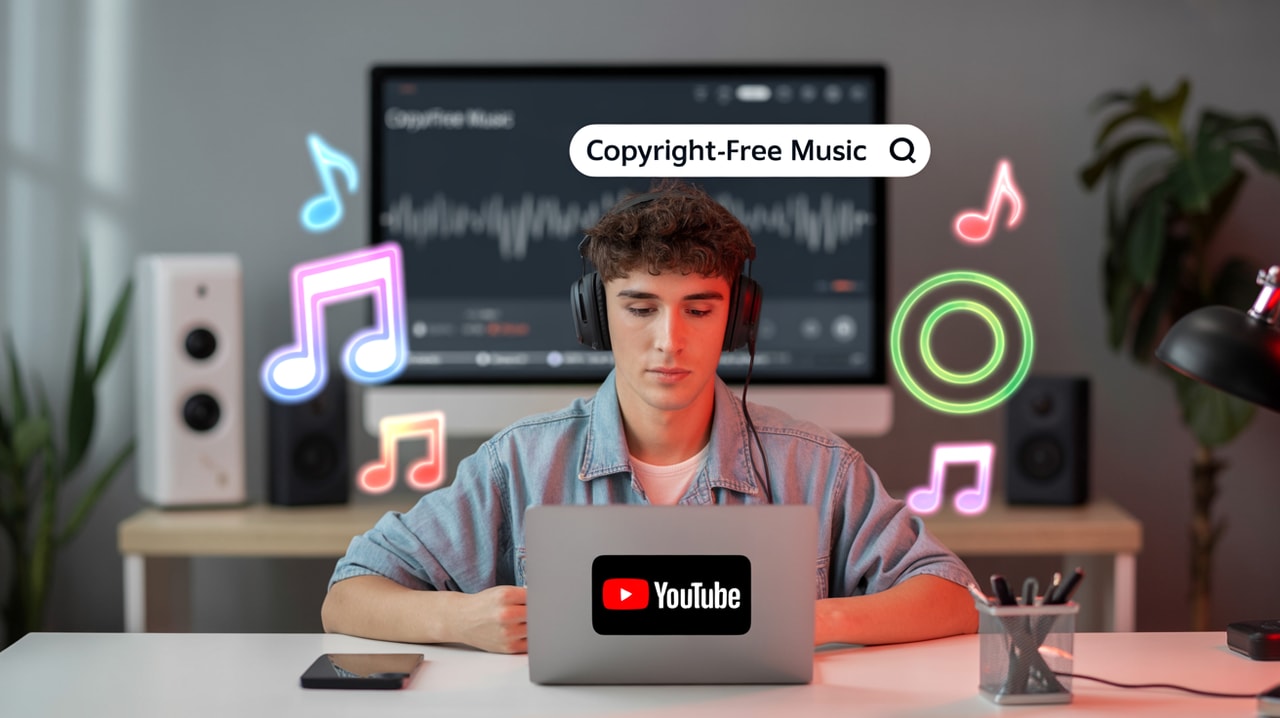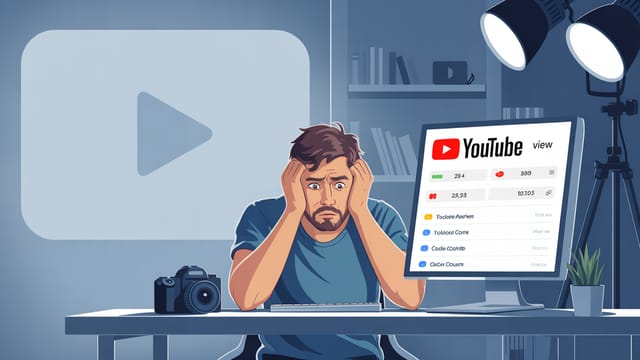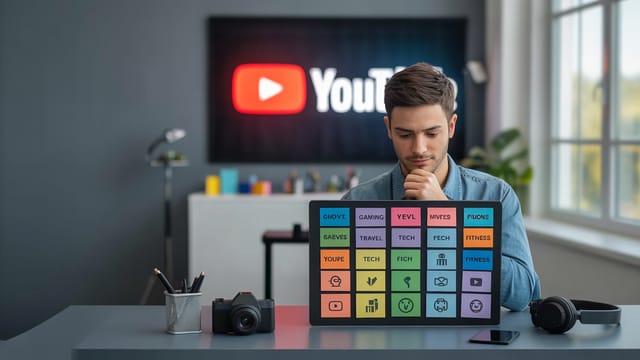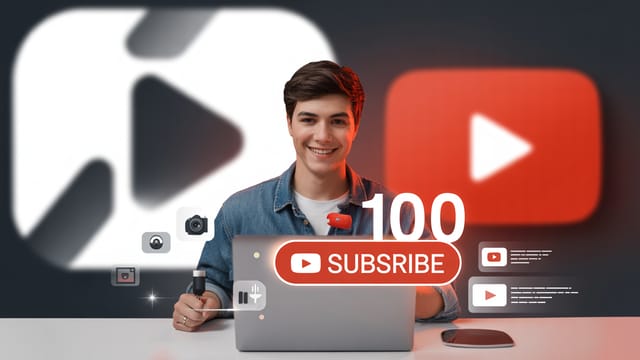
Ready to get your next 10,000 subscribers?
Join thousands of creators who use Subscribr to create faster, better YouTube videos.
Finding the perfect music for your YouTube videos can feel like a daunting task, especially when you're starting out. You want music that enhances your content, sets the right mood, and keeps viewers engaged. But lurking in the background is a major fear for many new creators: copyright strikes and the potential for demonetization.
Using music without the proper permission is one of the quickest ways to run into serious trouble on YouTube. It can lead to the copyright owner claiming the revenue from your video, blocking your video entirely, or even worse, hitting your channel with a copyright strike. Accumulating three strikes can result in your channel being permanently deleted, wiping out all your hard work, subscribers, and momentum. This risk makes finding genuinely safe music not just a creative choice, but an essential part of protecting your channel and your ability to monetize in the future.
So, how do you navigate the world of music licensing and find tracks you can use without legal headaches? This guide will walk you through the best sources for copyright-safe music and clarify common misconceptions.
Why Copyright Matters on YouTube: Understanding the Risks
YouTube uses an automated system called Content ID, alongside manual reviews, to detect copyrighted material. If you use music you don't have the rights to, the copyright holder can take action.
As revealed by insights from YouTube strategy experts, the consequences of using copyrighted music without permission can include:
- Monetization Claims: The copyright owner can claim all the ad revenue generated by your video. You do the work, they get paid.
- Video Blocking: Your video can be blocked globally or in specific countries, making it unviewable to your audience.
- Copyright Strikes: This is the most severe consequence. Three strikes can lead to channel termination. Think of it as a baseball game – three strikes, and you're out. Once you get a strike, it's difficult and often uncertain to get it removed.
A common misconception is that simply giving credit to the artist in your video description makes it okay to use their music. This is false. Crediting the source does not grant you permission to use copyrighted material. Permission must come directly from the copyright holder or through a proper license.
Copyright-Free vs. Royalty-Free: Clearing Up the Confusion
When searching for music, you'll often encounter the terms "copyright-free" and "royalty-free." While often used interchangeably, there's a subtle but important difference, especially in how they apply to licensing for YouTube:
- Copyright-Free: This term technically means the music is no longer protected by copyright law, usually because the copyright has expired or the creator has explicitly placed it in the public domain. While truly "copyright-free" music exists, it's often very old classical compositions. Finding modern, high-quality music that is genuinely free of all copyright can be difficult.
- Royalty-Free: This is a more common and practical term for YouTube creators. Royalty-free doesn't mean "free music." It means you pay a single license fee (or sometimes get the license for free under specific terms, like the YouTube Audio Library) to use the music without paying recurring royalty fees each time your video is played or viewed. The copyright still exists, but the license you obtain grants you permission to use the music under specified terms without owing ongoing payments to the copyright holder based on usage.
For YouTube purposes, when creators say "copyright-free," they usually mean "royalty-free music that I can use on YouTube without getting claims or strikes." The key is obtaining a valid license that permits use on the YouTube platform.
Where to Find Safe Music for Your YouTube Videos: A Resource Guide
Now that we understand why proper licensing is crucial, let's explore the best places to find music you can confidently use in your videos.
1. The YouTube Audio Library
Is the YouTube Audio Library completely safe to use? Yes. The YouTube Audio Library is YouTube's own collection of music and sound effects that creators can use in their videos for free. The licenses for these tracks are cleared for use on the YouTube platform, including for monetized videos.
- Pros: Completely free, directly integrated into YouTube Studio, licenses are guaranteed safe for YouTube.
- Cons: Selection can sometimes feel limited or generic compared to paid options, finding unique tracks can be challenging as many creators use the same library.
- How to Access: Go to YouTube Studio, scroll down the left-hand menu, and click "Audio library." You can search by genre, mood, instrument, duration, and attribution requirements.
Some tracks in the Audio Library require attribution (giving credit to the artist in your video description), while others do not. Always double-check the license type for each track you download.
2. Paid Royalty-Free Music Libraries
These platforms offer vast, high-quality libraries of music under subscription models or per-track licenses. This is where many professional creators source their music because the selection is usually much larger and more unique than free libraries.
- Examples: Epidemic Sound, Artlist, Storyblocks (which also offers stock footage and templates).
- Pros: Extensive and diverse catalogs, high-quality production value, easy-to-understand licensing that covers YouTube monetization, exclusive tracks not found elsewhere, often includes sound effects.
- Cons: Requires a paid subscription or per-track fee.
- Monetization Angle: Many of these platforms offer affiliate programs. As you create content helping new YouTubers find music, you can include your affiliate links to these services, earning a commission for sign-ups at no extra cost to the user. This aligns perfectly with the monetization opportunity for this article.
When using a paid library, ensure your subscription or license covers the specific type of use you need (e.g., use on YouTube, including monetized videos).
3. Creative Commons Music
Creative Commons (CC) licenses provide a standardized way for creators to share their work with others. Some music is released under CC licenses, allowing you to use it for free, but often with specific conditions.
- Examples: Free Music Archive, Jamendo (some CC licensed music).
- Pros: Can find high-quality music for free.
- Cons: Crucially, you must understand and comply with the specific CC license terms. The most common type for music on YouTube is CC BY (Creative Commons Attribution), which requires you to give appropriate credit to the creator. Failure to follow the attribution rules exactly can still lead to copyright issues. Other CC licenses may restrict commercial use (NC - NonCommercial) or prevent modifications (ND - NoDerivatives), which might not be suitable for YouTube videos you plan to monetize or edit.
- Caution: Always verify the source and the specific license terms. Ensure the person who uploaded the music actually had the right to apply a CC license to it.
4. Public Domain Music
Music enters the public domain when its copyright expires. This typically happens a significant number of years after the creator's death (the exact duration varies by country). Public domain music is genuinely "copyright-free."
- Examples: Many classical compositions by artists like Beethoven, Mozart, etc., are in the public domain.
- Pros: Truly free to use without permissions or fees.
- Cons: The selection of modern music is virtually non-existent. Recordings of public domain music can be copyrighted, so you need to ensure you are using a public domain recording or create your own.
- How to Find: Look for libraries or archives specifically dedicated to public domain music.
Can I Use Popular Songs If I Give Credit?
This is a frequent question, and the answer, as highlighted by YouTube strategy experts, is almost always no. As mentioned earlier, giving credit is not a substitute for obtaining a license. Popular songs are typically owned by major record labels and music publishers. The cost of licensing a popular song for use on YouTube is usually prohibitively expensive for individual creators, often costing thousands or tens of thousands of dollars.
Using even a small snippet of a popular song without permission can trigger Content ID and result in claims or strikes. While Fair Use is a legal doctrine that can potentially allow limited use of copyrighted material for purposes like commentary or criticism, it is a complex legal defense and not a guaranteed right to use copyrighted music. Relying on Fair Use for background music is extremely risky and not recommended for new creators.
Best Practices for Using Music Safely
To ensure you never face copyright issues with your video soundtracks:
- Use Reputable Sources: Stick to the YouTube Audio Library, well-known paid royalty-free music sites, or carefully verified Creative Commons music where you fully understand the license.
- Read the License: Always read and understand the terms of the license for each track you use. Ensure it permits use on YouTube and for commercial purposes if your channel is monetized.
- Keep Records: Save the license information or note the source and license type for each track you use. This can be helpful if you ever receive a claim.
- Provide Attribution When Required: If a license (like some Creative Commons or YouTube Audio Library tracks) requires attribution, include it accurately in your video description as specified by the license terms.
- When in Doubt, Don't Use It: If you're unsure about the source or licensing of a piece of music, don't use it. It's not worth risking your channel.
Planning Your Content with Subscribr
Creating professional YouTube videos involves more than just filming and editing; it requires careful planning, research, and understanding platform guidelines like music licensing. This is where a tool like Subscribr can be invaluable for new creators.
Subscribr's Script Building Pipeline helps you structure your entire video creation process, from initial research to final script. As you plan your video, you can use Subscribr's Research Assistant to find information on music licensing sources or specific libraries you're considering. You can import notes about license terms directly into your script workspace.
By integrating the step of finding and clearing music before you even start editing, you can avoid potential copyright pitfalls down the line. Subscribr helps you keep all your research, script notes, and production considerations in one place, ensuring you follow a safe and compliant workflow.
Conclusion
Navigating music licensing is a crucial step for any aspiring or new YouTuber. While the fear of copyright strikes and demonetization is real, it shouldn't prevent you from using music to enhance your content. By understanding the difference between copyright-free and royalty-free, and by utilizing reliable sources like the YouTube Audio Library and paid royalty-free libraries, you can find fantastic music that keeps your channel safe and your monetization intact. Always prioritize using music with clear, YouTube-compatible licenses, and never rely on simply giving credit for popular songs. Taking these steps will protect your channel and allow you to focus on creating great content that resonates with your audience.





